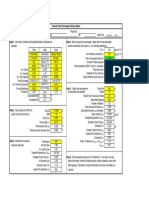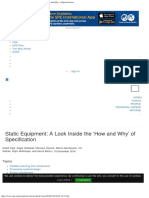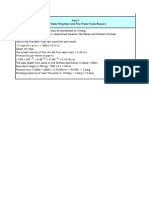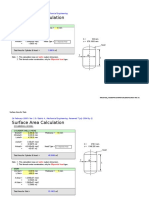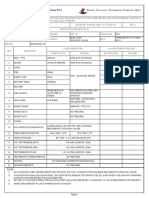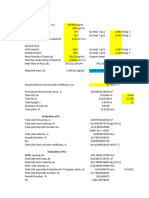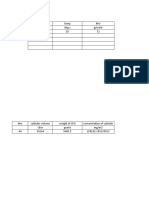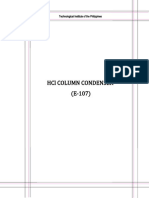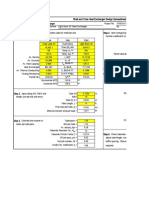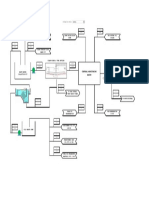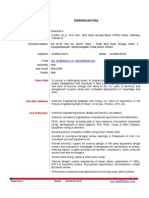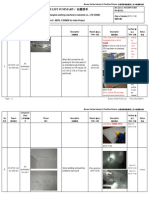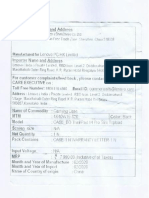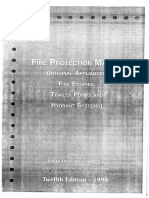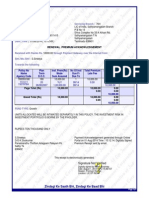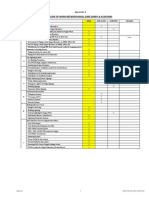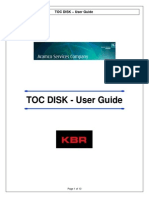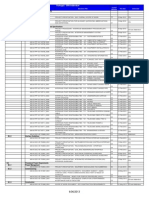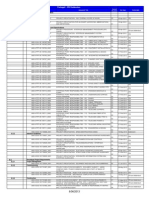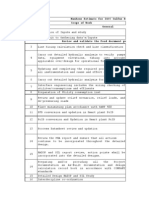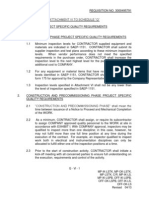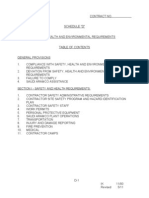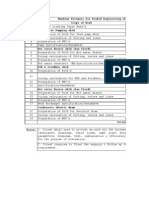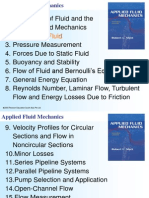Tubular Heat Exchanger Rating Sheet: Start 2 o 2 o
Uploaded by
SIVATubular Heat Exchanger Rating Sheet: Start 2 o 2 o
Uploaded by
SIVATubular Heat Exchanger Rating Sheet
Project Item No. Low Pressure Feed water Heater sizing Service Feed water Heating Project No. By Date/Time
19-Nov-13 12:46
Step 1. Input flows, conditions and properties data for shellside and tubeside. Tube Side Shell Feed Water 3 54 283.0 114.8 206.6 61.089 0.397 1.007 3 27 44 337 0.384 0.0002 2.52 Fluid Name Flow (M), lb/h Temp. in, oF Temp. out, oF , lb/ft3 , cP cp, Btu/lb oF Q, Btu/h k, Btu/hft oF R, ft2h oF/Btu cp /k 16.0 14.4
o o
Step 4. Start configuring the exchanger. Begin with the total calculated transfer coefficients to this point (i.e., not including shellside h): Ustart = 120 On that basis, assumed Uo = Then the required transfer A = Number of tubes required = Reset tubes/pass (Step 3), then no. of passes = Total tube count = Tubeside P (incl. returns) = Actual effective transfer area, A = 315 7 219 1 484 2 450 1.408 2 189
Btu/hft2 oF Btu/hft2 oF ft2
LP Steam 30 994.0 222.8 131 0.0417 0.012 0.4814 3 27 45 161 0.1937 0.0002 0.07 F F
Av. Density Av. Viscosity Av. Heat Capacity Heat Exchanged Av. Thermal Conductivity Fouling Resistance Prandtl No.
psi ft2
Step 5. Select tube arrangement and estimate shell diameter
Tube Pitch Pattern
0.94 Tri 27 6.75 43 0.256 1.080 1 21 157 8 78 010 0.00089 0.282 643.9 584 300.7 -4.7% 341.8
in. in. in. ft2 in. lb/hft2
Uncorrected MTD Corrected MTD
Step 2. Input tubing OD, BWG and length (can be trial and error).
Tube OD BWG Tube ID, d =
0.7500 16 0.620 24.78 0.302 4.866
in. in. ft. in.2 ft2
Shell ID from Tube Count Tables Select Baffle Spacing Number of Baffles = Flow Area across Bundle, as = Equivalent Diameter, de (see table) = Mass Velocity, Gs = Shellside Reynolds No., NRe = Shellside Friction Factor = Shellside P = Outside Transfer Factor, jh = Outside Film Coefficient, ho = Calculated Uo = Check: % difference, Ucalc. vs Uassum. = Uclean =
Tube Length, L = Flow area per tube, at = Effective transfer area per tube =
psi
Step 3. Estimate the number of tubes per tube pass.
Tubes/pass = lb/h per tube = Av. velocity, fps = Tubeside Reynolds No., NRe = Tubeside Friction Factor, f = P per pass, psi = Nusselt number, Nr = Inside Film Coefficient, hi =
225 1 575 3.41 40 409 0.010 0.38 11.09 824
Step 6. Check tubeside velocity and P, shellside P. If too high or too low, adjust tube length, number of tubes per pass, number of passes, and/or shell baffle spacing. Remember to reset shell diameter from tube count tables, as required.
You might also like
- Tubular Heat Exchanger Rating Sheet: Start o 2 o o 3 2 o 2 oNo ratings yetTubular Heat Exchanger Rating Sheet: Start o 2 o o 3 2 o 2 o1 page
- Tank Agitator Data Sheet: (Garamond 14)No ratings yetTank Agitator Data Sheet: (Garamond 14)10 pages
- IPS MBD21907 in 522 Datasheet of Emergency Relief Valve ANo ratings yetIPS MBD21907 in 522 Datasheet of Emergency Relief Valve A3 pages
- Surge Vessel Testing: (Update As of 30th April 2015)No ratings yetSurge Vessel Testing: (Update As of 30th April 2015)2 pages
- Static Equipment - A Look Inside The How and Why' of SpecificationNo ratings yetStatic Equipment - A Look Inside The How and Why' of Specification16 pages
- MGT (Manifold Group Trunkline) System For The Gcs 29, 30 and 31 in North Kuwait Company Contract No.: 15051614 Petrofac Job No.: JI-2031No ratings yetMGT (Manifold Group Trunkline) System For The Gcs 29, 30 and 31 in North Kuwait Company Contract No.: 15051614 Petrofac Job No.: JI-20319 pages
- Heat Exchanger Specification Sheet SI 2 Units: D:/HE/PLN/SHE - HtriNo ratings yetHeat Exchanger Specification Sheet SI 2 Units: D:/HE/PLN/SHE - Htri1 page
- DJM-MBA-PCS-CA-018 LPG On-Spec Storage REV-BNo ratings yetDJM-MBA-PCS-CA-018 LPG On-Spec Storage REV-B3 pages
- 37 FA10871C J 01 - REV D Design Instruction MechNo ratings yet37 FA10871C J 01 - REV D Design Instruction Mech117 pages
- Hoja de Datos Sistema Aire Comprimido ReferencialNo ratings yetHoja de Datos Sistema Aire Comprimido Referencial18 pages
- 14960-000-ME-DAS-003 Data Sheet For Sump PumpsNo ratings yet14960-000-ME-DAS-003 Data Sheet For Sump Pumps8 pages
- 6700-EQS-2800-EC-0004 - EC 2802 - Flash Cooler Condenser - R01No ratings yet6700-EQS-2800-EC-0004 - EC 2802 - Flash Cooler Condenser - R019 pages
- SQ8167 - 01 - Methanol Reboiler - BKU Option - (Alt Case 10 Deg Approach) .HTRI 6th Aug 21-CmtdNo ratings yetSQ8167 - 01 - Methanol Reboiler - BKU Option - (Alt Case 10 Deg Approach) .HTRI 6th Aug 21-Cmtd4 pages
- Stoichiometry and Process Calculations - K. v. Narayanan and B. LakshmikuttyNo ratings yetStoichiometry and Process Calculations - K. v. Narayanan and B. Lakshmikutty167 pages
- LFL Temp MW V% in Air Deg C G/mole 1.7 25 72No ratings yetLFL Temp MW V% in Air Deg C G/mole 1.7 25 724 pages
- HCL Column Condenser (E-107) : Technological Institute of The PhilippinesNo ratings yetHCL Column Condenser (E-107) : Technological Institute of The Philippines54 pages
- L.3.1. EVAPORATOR - 01 (EV-01) : 1 o o o oNo ratings yetL.3.1. EVAPORATOR - 01 (EV-01) : 1 o o o o9 pages
- Shell and Tube Heat Exchanger SpreadsheetNo ratings yetShell and Tube Heat Exchanger Spreadsheet2 pages
- Operation Mode: Central Monitoring BasinNo ratings yetOperation Mode: Central Monitoring Basin1 page
- Punch List Summary For PUCNP-14040-APH-010 - 2015!11!06 ClosedNo ratings yetPunch List Summary For PUCNP-14040-APH-010 - 2015!11!06 Closed4 pages
- Renewal Premium Acknowledgement: Collecting Branch: E-Mail: Phone: Transaction No.: Date (Time) : Servicing BranchNo ratings yetRenewal Premium Acknowledgement: Collecting Branch: E-Mail: Phone: Transaction No.: Date (Time) : Servicing Branch1 page
- Inputs From Client: 1. bfp132401 1 0 (G.A. Drawing For SWS Gas KO Drum)No ratings yetInputs From Client: 1. bfp132401 1 0 (G.A. Drawing For SWS Gas KO Drum)3 pages
- S.No Scope of Work Manhour Estimate For IGCC Sulfur Recovery Unit GeneralNo ratings yetS.No Scope of Work Manhour Estimate For IGCC Sulfur Recovery Unit General4 pages
- S.No Scope of Work Feed Water Pumping Skid Manhour Estimate For Prebid Engineering of Fuel Gas SystemNo ratings yetS.No Scope of Work Feed Water Pumping Skid Manhour Estimate For Prebid Engineering of Fuel Gas System2 pages
- Codan Rubber Modern Cars Need Modern Hoses WebNo ratings yetCodan Rubber Modern Cars Need Modern Hoses Web2 pages
- CHE-S402-Chapter11-Fluid-fluid-reaction-kinetics-Part3No ratings yetCHE-S402-Chapter11-Fluid-fluid-reaction-kinetics-Part311 pages
- Isolation of Process Equipment in Oil Gas ProjectNo ratings yetIsolation of Process Equipment in Oil Gas Project18 pages
- ME 522 - Power Plant Engineering - Review Problems100% (1)ME 522 - Power Plant Engineering - Review Problems54 pages
- Emission Control: Exhaust Emissions Are Produced by Cars, Buses, and100% (1)Emission Control: Exhaust Emissions Are Produced by Cars, Buses, and10 pages








